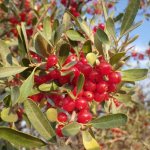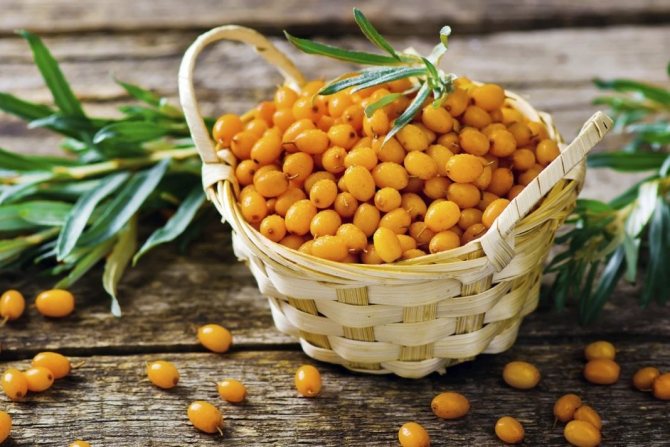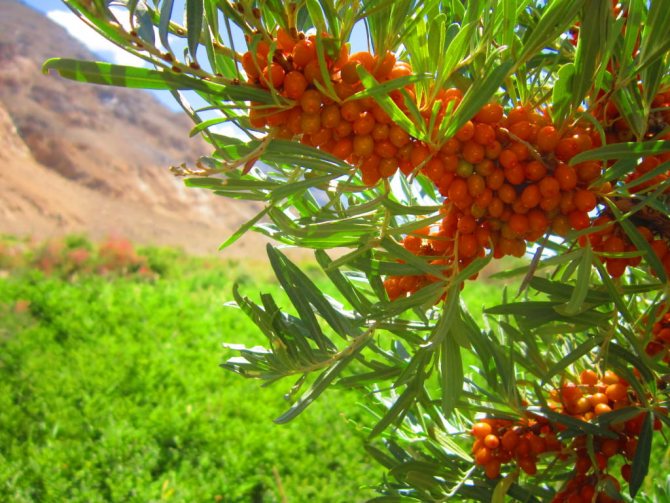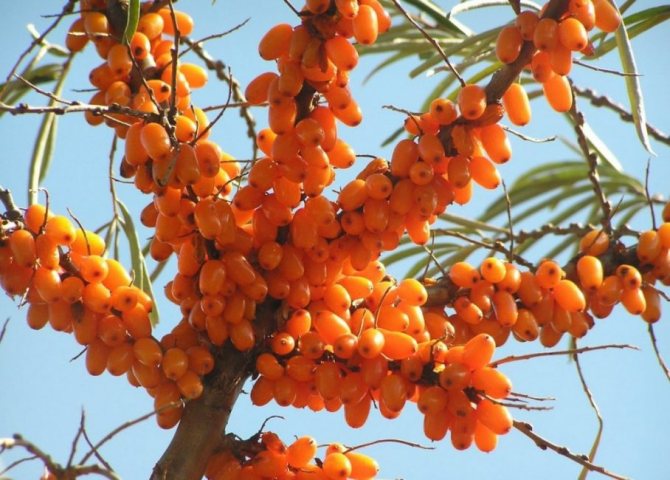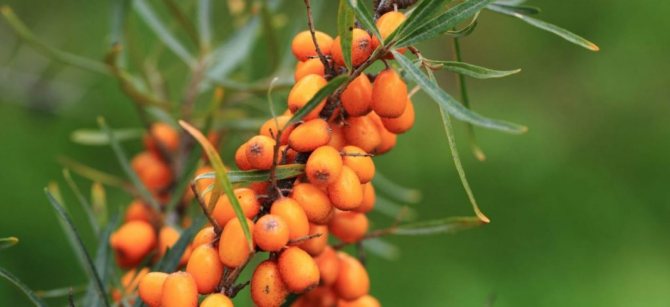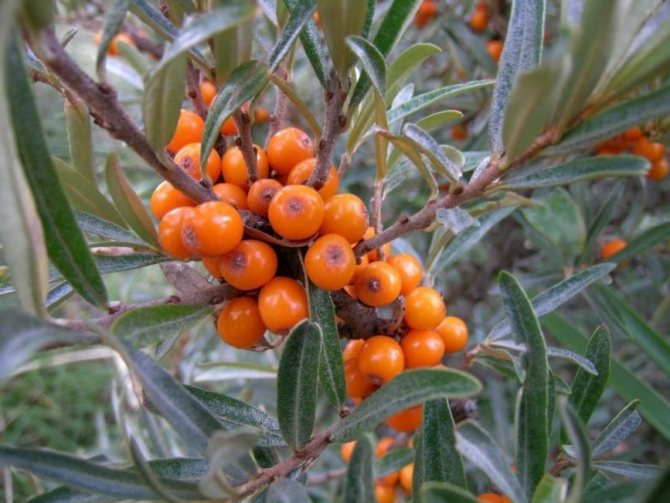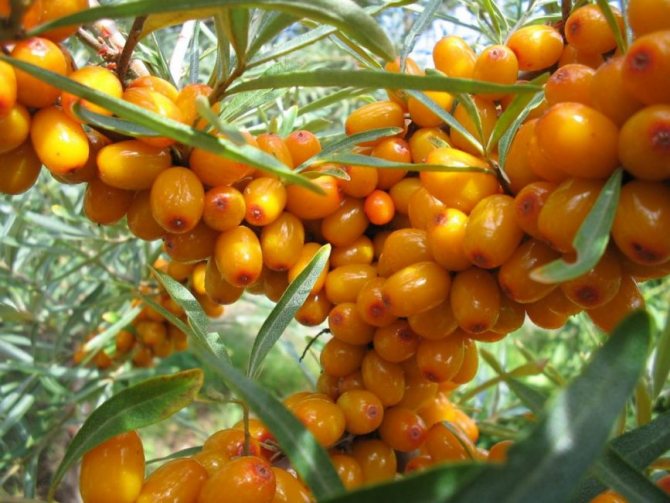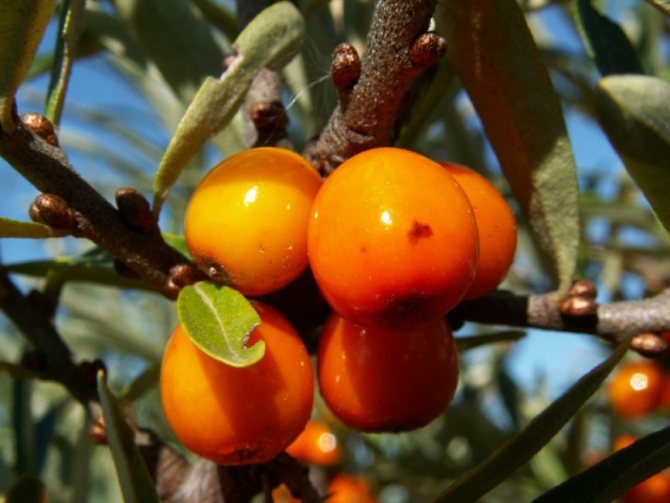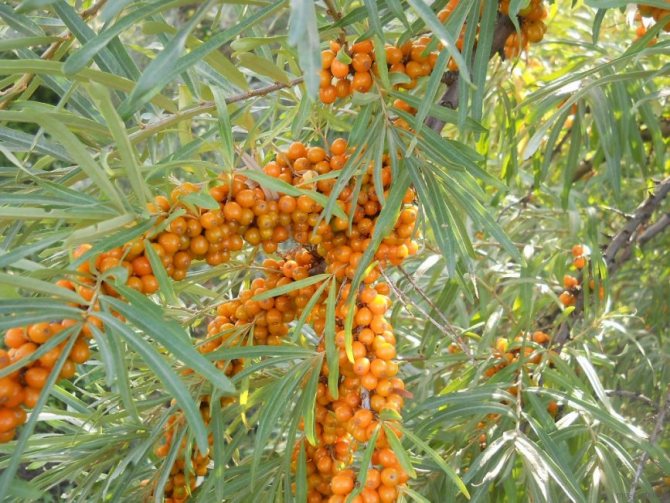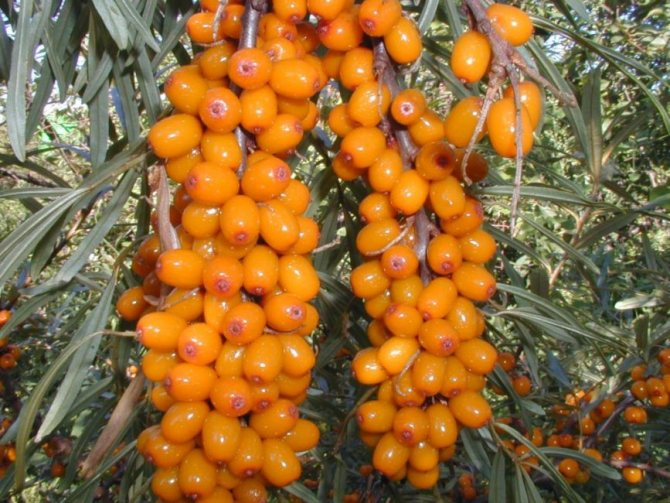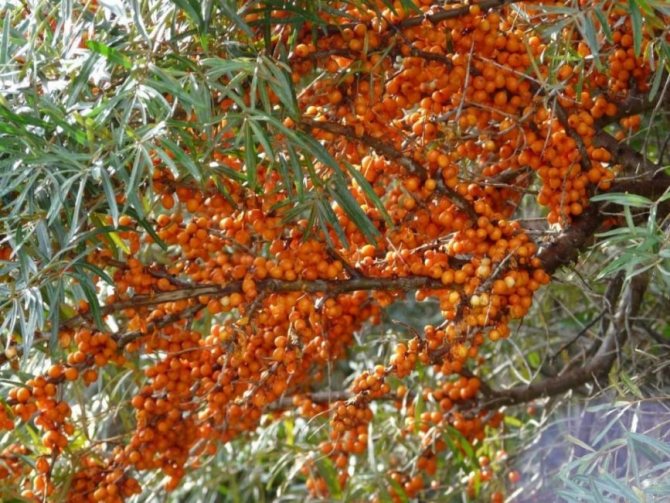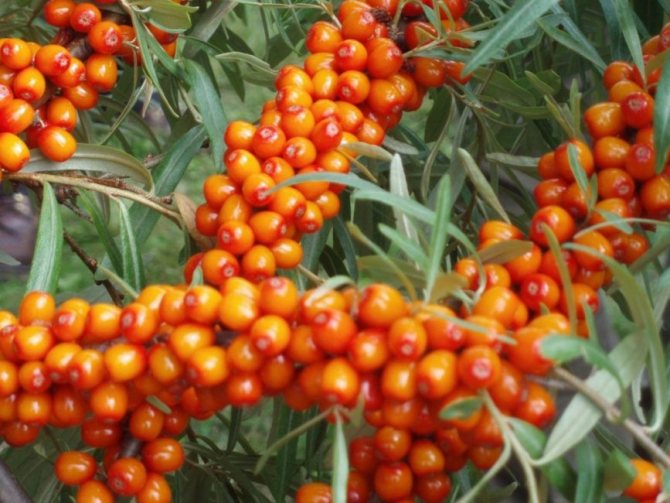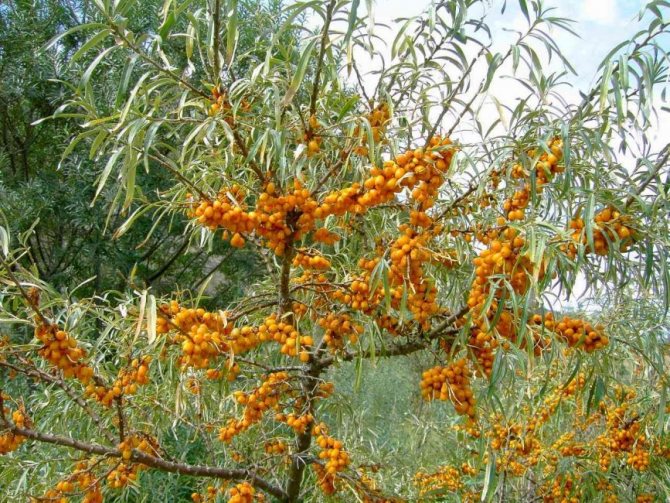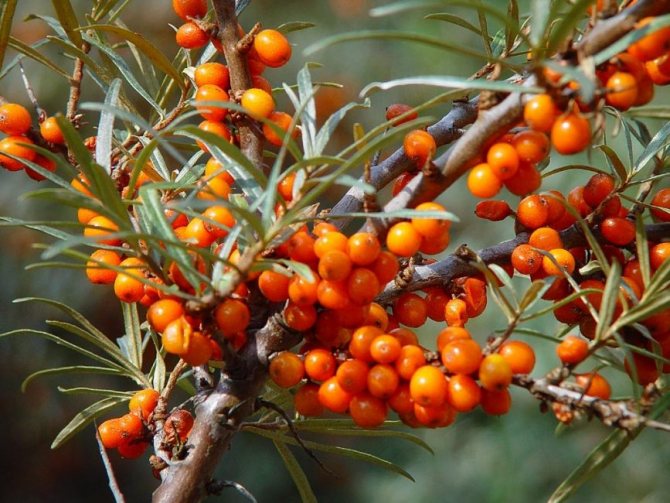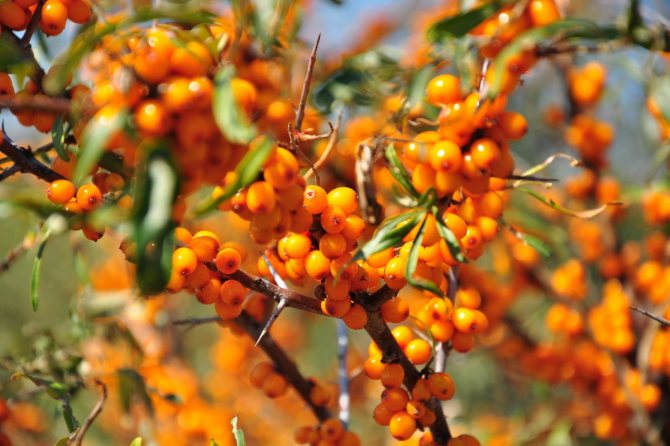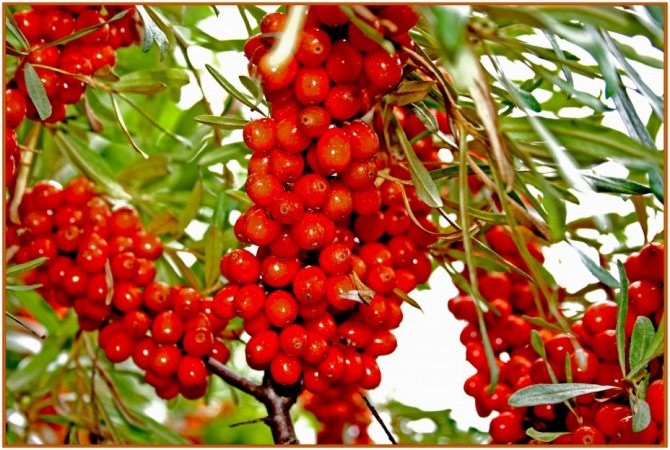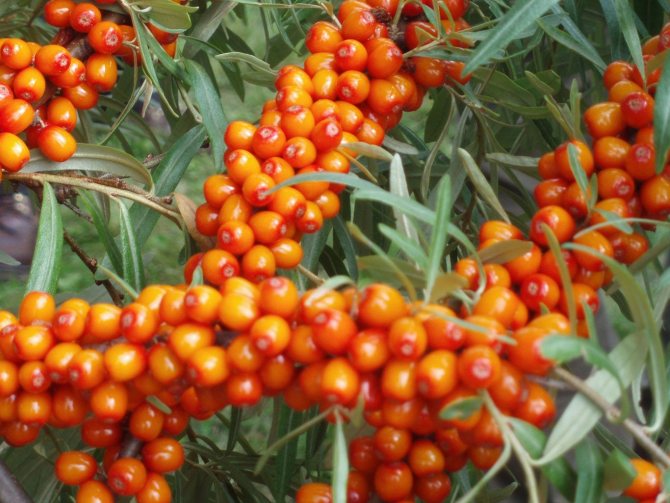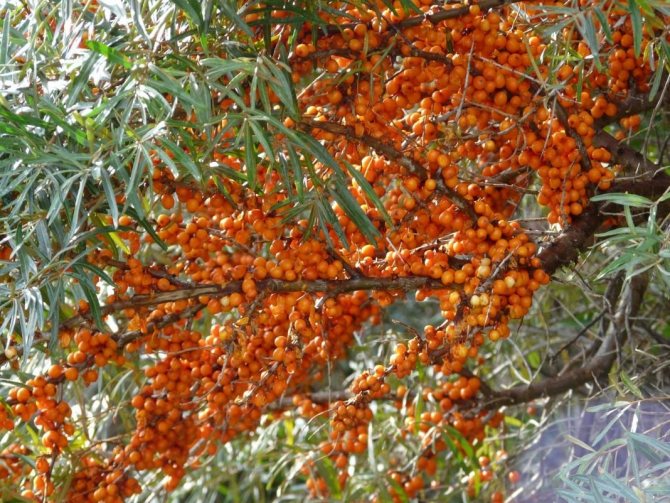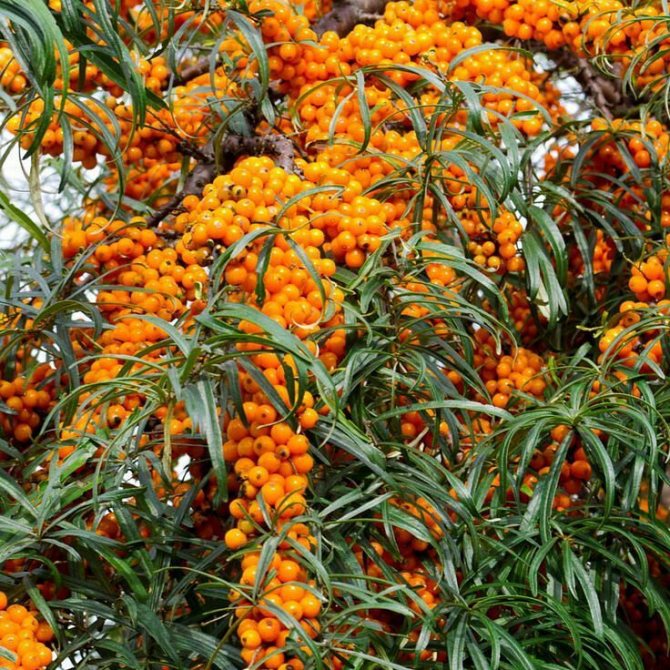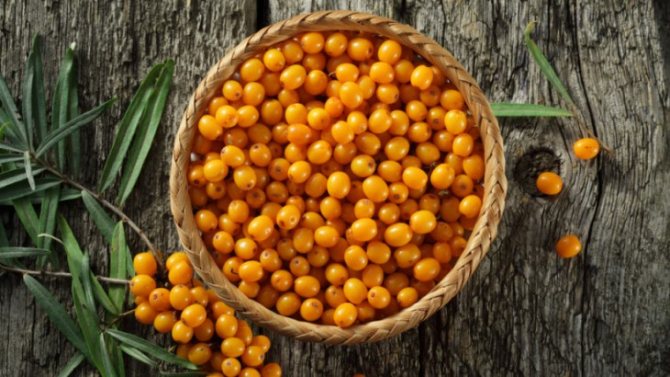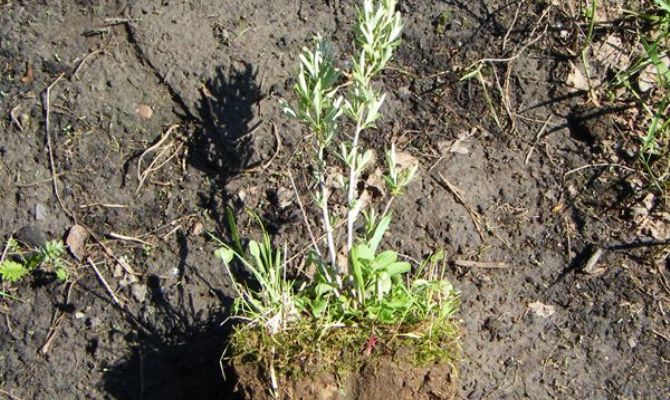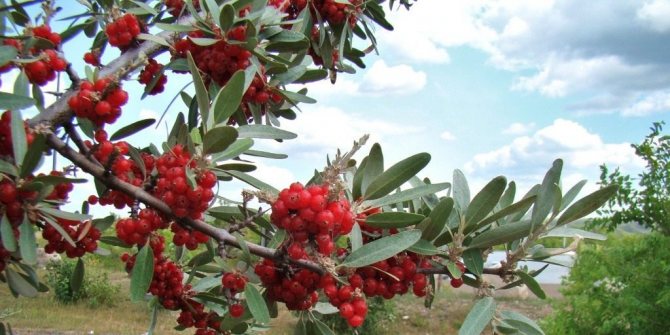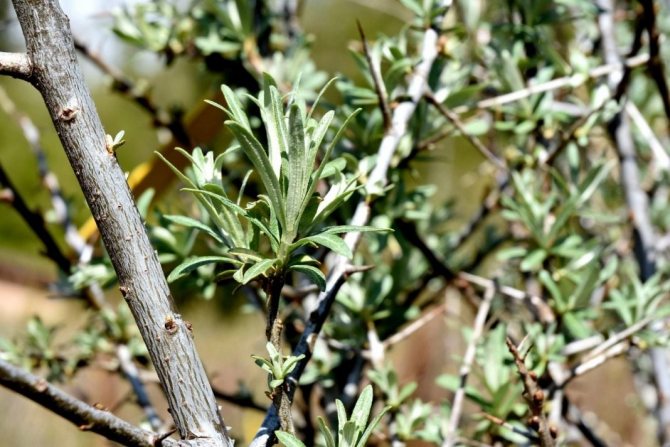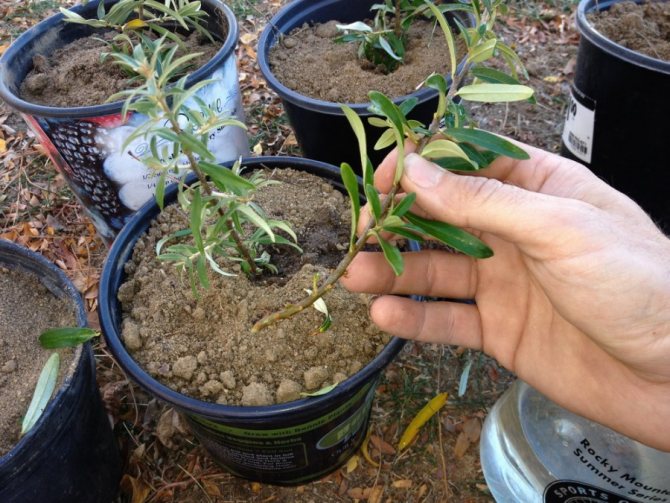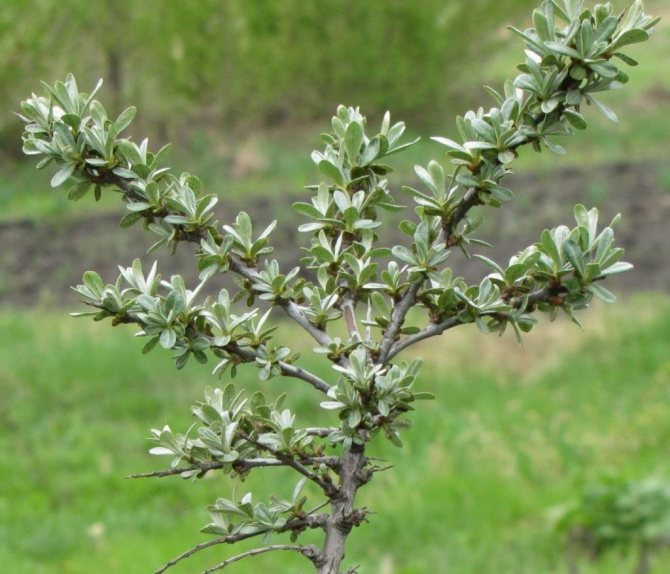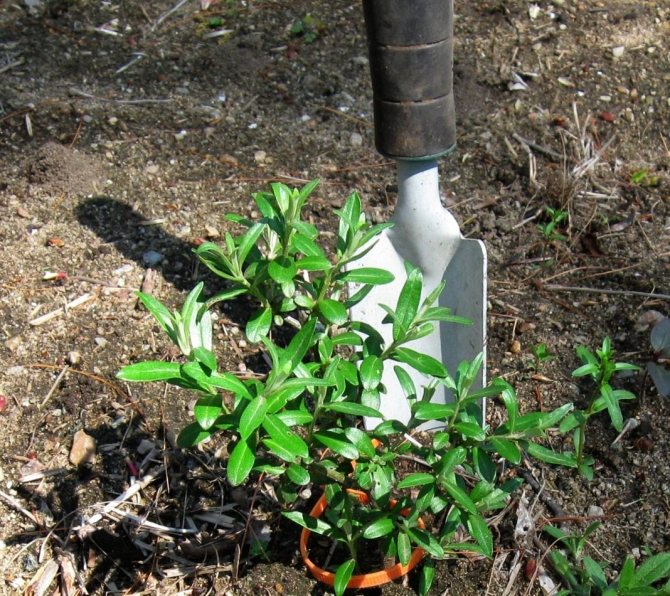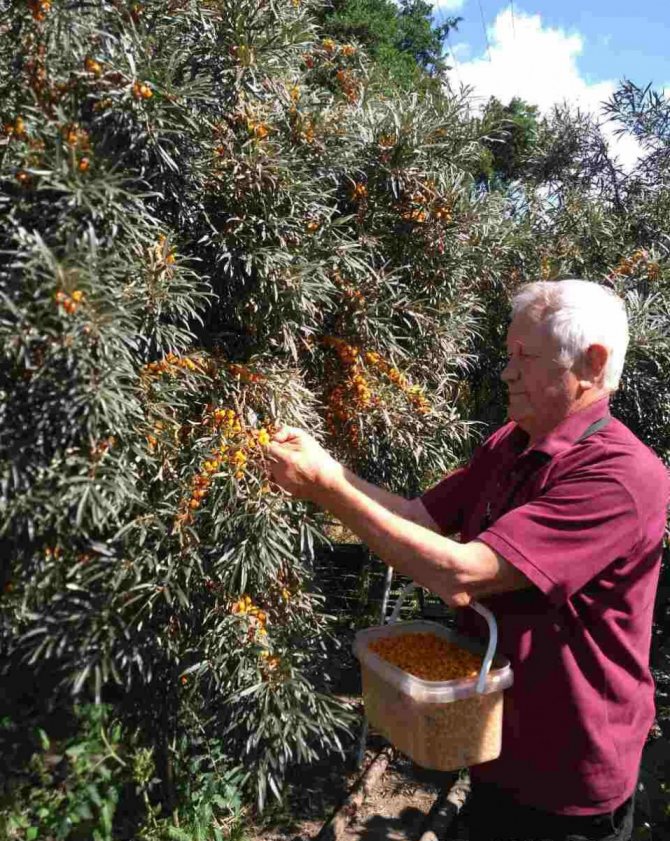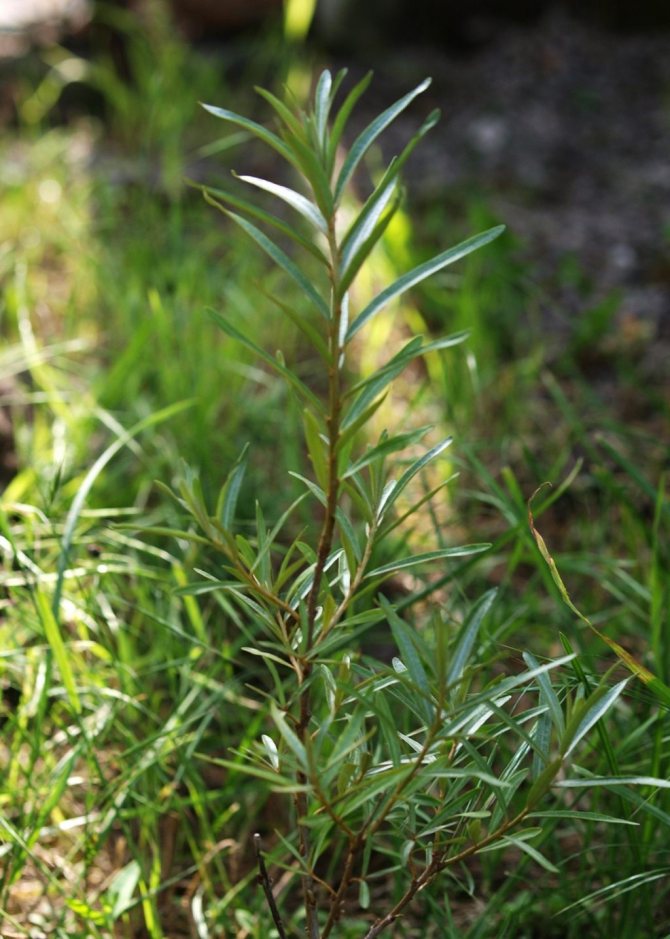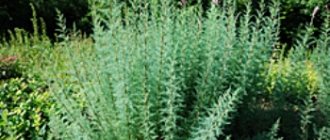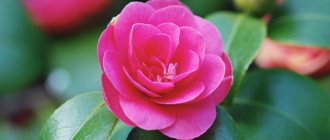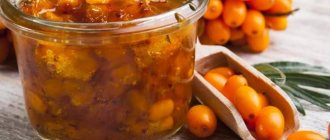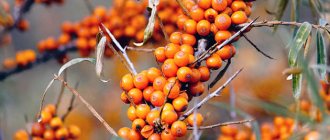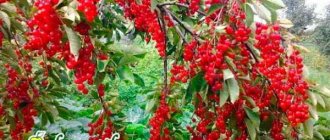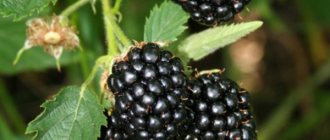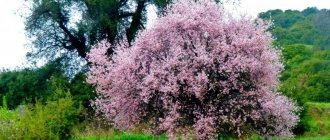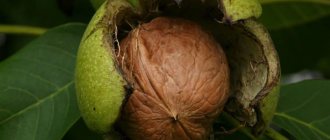I learned about Shepherdia that she is similar in her merits to our sea buckthorn. Sea buckthorn on my site was grown quite good at one time, only in order to save the land plot I had to uproot it, which was a rather laborious business, since its roots turned out to be quite powerful. Now I understand that it would be easier and more useful to transplant sea buckthorn plants behind the hedge, outside the site: let them decorate the landscape in front of the house with their silvery greenery. You see, it would be possible, on occasion, to collect some kind of harvest of very useful berries. True, when the sea buckthorn ripened, it was necessary to look "both ways": the birds feasted on the berries so actively that after a couple of days they removed the entire harvest "for clean".
Shepherdia is silvery.
So, remembering sea buckthorn, I felt sympathy for a plant similar to it. This happens when, recalling pleasant episodes of the past for us, we find with emotion something similar in the present. For example, a young man or girl, having lost his first love for some reason, willingly or unwittingly, and most likely subconsciously, seeks to meet something similar to his past love. Or wise nature arranges so that the image of the ideal for love in the soul of a young man or girl is formed in such a way that he (the ideal), like two drops of water, becomes like a loved one from the closest members of his family: mother, father, grandmother, etc. ... May the reader forgive me for my involuntary lyrical digression, (I confess) but this is so, and any psychologist could confirm my thoughts. Something similar happened to me in the story with sea buckthorn and shepherd
Shepherdia berries seemed to me even more attractive than sea buckthorn. Moreover, studies have confirmed the high nutritional and medicinal-dietary qualities of shepherd's fruits. They contain many valuable nutrients in a very favorable combination. Shepherdia fruits contain about 21 percent of sugar, up to 3.5 percent of organic acids, a lot of vitamin C, carotene (provitamin A), catechins and other valuable substances.
The fruits of Shepherdia are highly appreciated by specialists after their experienced use in winemaking, when making jams, in preparing liqueurs, tinctures, and jellies. I.V. Michurin himself considered shepherdia an indispensable berry for making wine liqueurs (which is no reason to feel additional sympathy for this overseas plant). So I decided to contribute to the popularization of Shepherdia, supplementing the above-mentioned excellent article with material on the cultivation of this relative of sea buckthorn.
Shepherdia (Shepherdia) is a genus of plants of the family Lochaceae, or Sea Buckthorn (Elaeagnaceae), which includes 3 species of small shrubs native to North America.
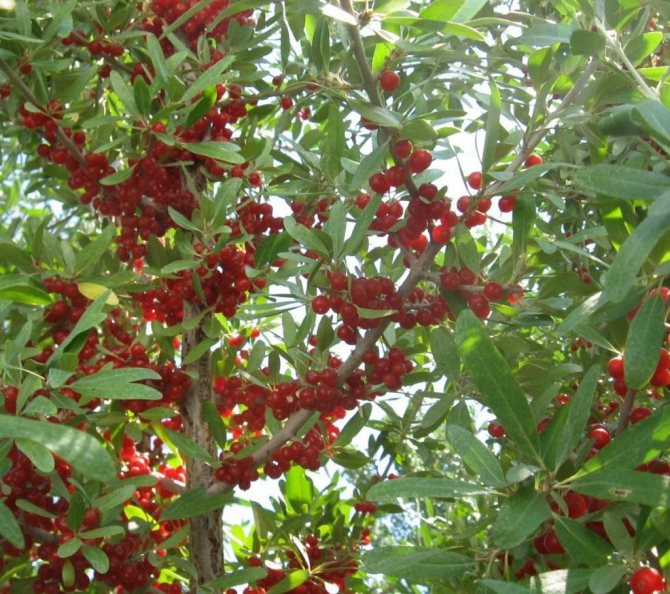
Shepherdia silvery, or Buffalo Berry.
Description
Sea buckthorn is small, of only six species, a genus in the Lokhovye family. Deciduous trees and shrubs grow in the temperate zones of the world, mainly in the floodplains of rivers and near stagnant bodies of water.
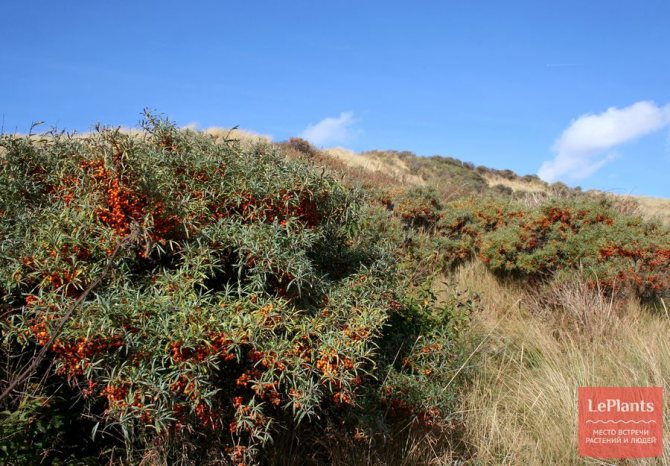

ON THE PICTURE: There are some types of sea buckthorn and high in the mountains.
Sea buckthorn has a powerful root system. Lateral roots grow on the sides in the surface layers to such a length that the diameter of the root system is several times the diameter of the crown.Nodules that assimilate nitrogen are formed on the roots.
The height of trees and shrubs ranges from 2-6 meters, but some species grow up to 11 m. These plants live for decades. Young shoots are covered with silvery scales, adults are yellow or dark brown.
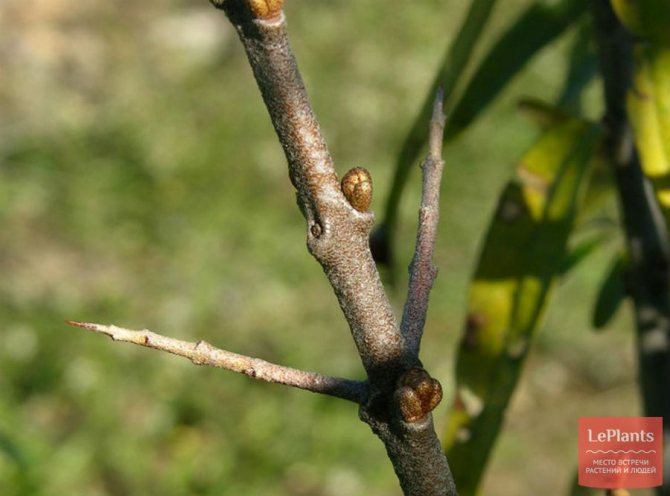

ON THE PICTURE: The branches of the Sea Buckthorn are decorated with sharp long thorns.
Flowers and leaves bloom almost simultaneously in spring. The leaf blades are narrow (lanceolate or linear) with a blunt or slightly pointed tip. Leaves sit on short petioles, arranged alternately. The front surface is grayish-green, a light fluff on the seamy side gives a silvery-white tint.
Sea buckthorn is a dioecious plant. On male specimens, flowers are collected in small ears of a dirty green color. Women's - small, petalless, yellowish.
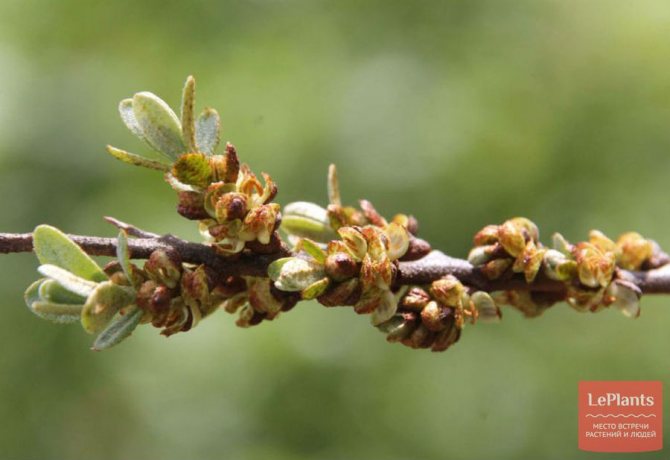

ON THE PICTURE: Male flowers of Sea buckthorn.
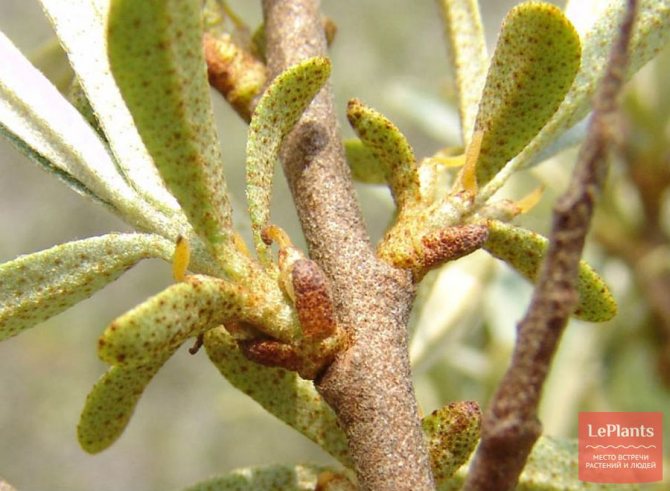

ON THE PICTURE: Female sea buckthorn flowers.
Nondescript flowers without nectaries do not attract insects, the wind carries pollen. As a result, fruits appear on female plants at the end of summer - false drupes. The tough nutlet is covered with a juicy receptacle. There are so many “berries” of yellow, red, orange colors that they literally stick around the shoots.
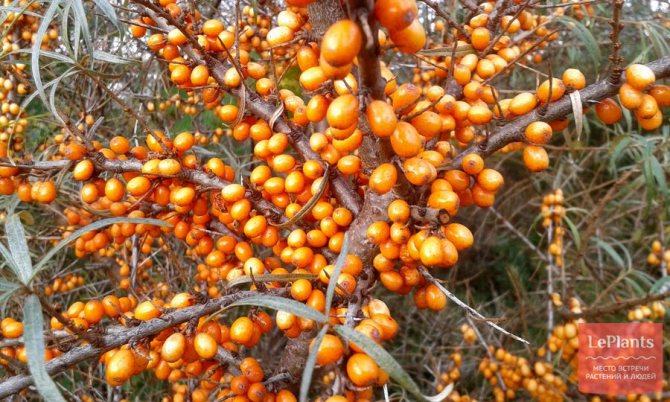

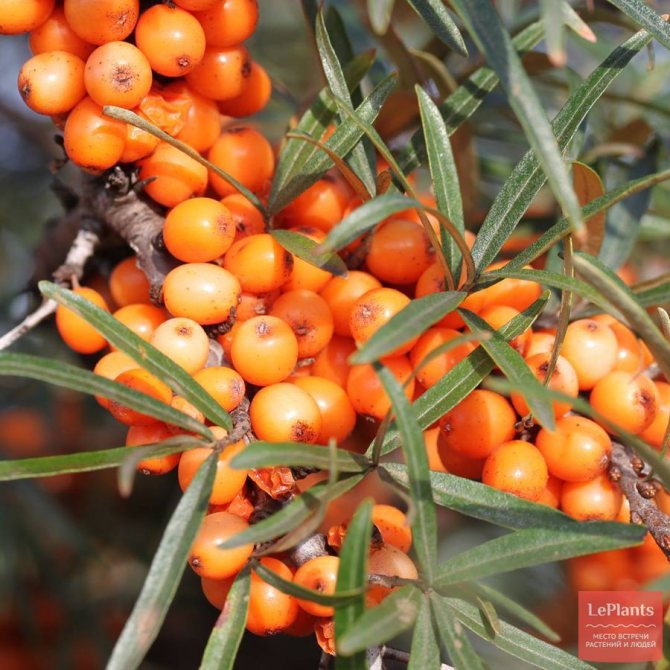

ON THE PHOTO: Sea buckthorn fruits can stay on the branches for a long time, almost all winter, but this is not always possible, since birds are happy to eat them.
In cooking, false drupes are used to make juices, wine, compotes. They are considered important ingredients in various sauces, desserts, salads. The fruits of the plant are good in fresh, dry, canned form.
Sea buckthorn fruits are a storehouse of nutrients. They contain vitamins (C, E, P and group B), micro- (manganese, aluminum, titanium) and macronutrients (calcium, magnesium, potassium).
In official and traditional medicine, sea buckthorn oil is actively used. It contains tocopherol, carotenoids, glycerides of acids (palmitic, stearic, oleic, linoleic). The oil helps with bedsores and burns. It is prescribed for the treatment of dental, ophthalmic, gynecological and oncological diseases.
In culture, Sea buckthorn is grown not only as a fruit crop, but also for decorative purposes.
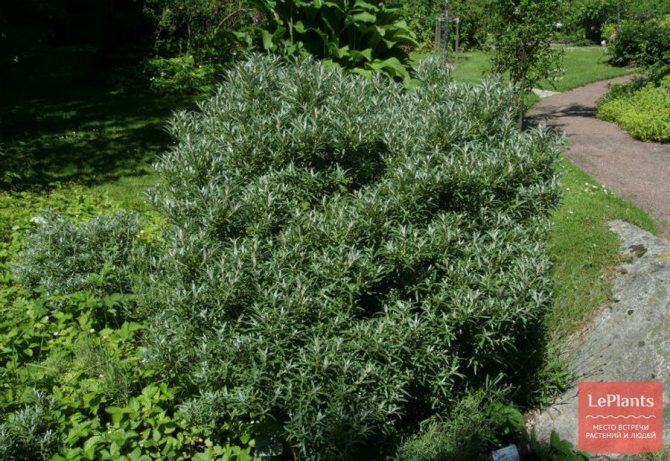

ON THE PICTURE: Sea buckthorn bushes make luxurious hedges. In addition, these plants are excellent for strengthening the slopes.
In 2012, the most famous and widespread species in Russia Buckthorn buckthorn (Hippophae rhamnoides) was transferred to another genus. She is now officially recognized by the Elaeagnus rhamnoides. The old name has become a synonym. However, gardeners, breeders, sellers of seedlings still call the plant and its many varieties Sea buckthorn.
Large-fruited varieties
Under natural conditions, with normal development, sea buckthorn has rather small fruits, each of which weighs no more than 0.4 g. It will take a long time and a sufficient number of trees to collect the required number of fruits.
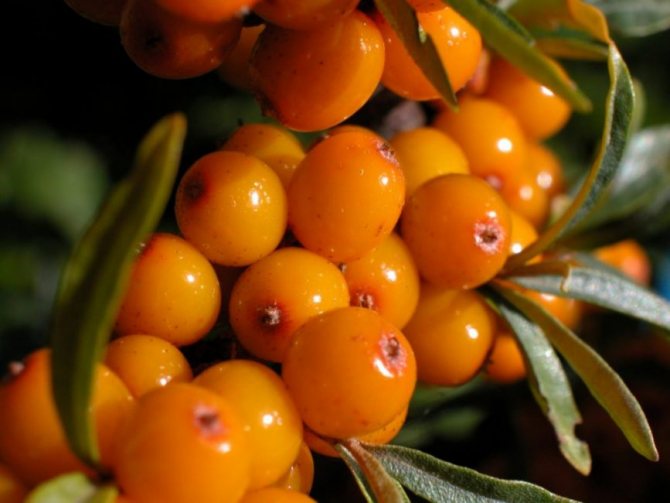

Large-fruited sea buckthorn
To save time, breeders specially bred several varieties of sea buckthorn with large fruits, each of which can reach up to 1.5 grams. At the same time, most of the gustatory characteristics have been completely preserved, the appearance and other properties of the stem are also largely preserved.
Most large-fruited varieties are distinguished by abundant fruiting, but this does not last long. Already after 5-7 years, the fruits become smaller and the yields become less abundant.
Next, we will get acquainted with the most popular varieties among gardeners, which have proven themselves on the positive side.
back to menu ↑
See also: Cherry: a description of the 20 best varieties, characteristics and reviews of gardeners |
Openwork
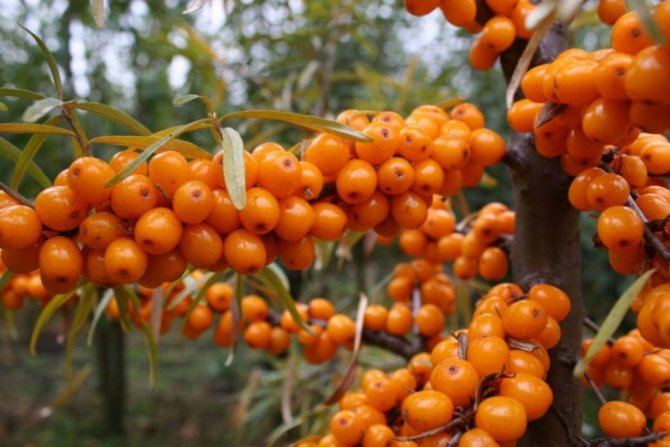

Sea Buckthorn Openwork This variety has come to the taste of many experienced gardeners and beginners in this business.It is easy to grow, the stem is not picky about soil and weather conditions, it bears excellent fruit in any region.
An adult fruiting tree of the Azhurnaya variety has a wide spreading crown, in addition, the stem stands out:
- the complete absence of thorns on the branches
- large cylindrical fruits of orange color
- early ripening of berries
- abundant fruiting
During the first tests in the harsh north, Openwork sea buckthorn showed high resistance to frosting of buds and branches. She is not afraid of most fungal diseases affecting the fruit trees of the garden, the stem perfectly tolerates the dry months of summer and will not die with an abundance of moisture in the spring-autumn period.
The harvested crop perfectly tolerates long-distance transportation. The berries are eaten fresh and preserved in various ways. Openwork sea buckthorn is subject to conservation, freezing and other types of processing for a longer preservation.
back to menu ↑
See also: Persimmon: description and characteristics of the 9 best varieties. Early and late varieties (20 Photos & Videos) + Reviews
Augustine
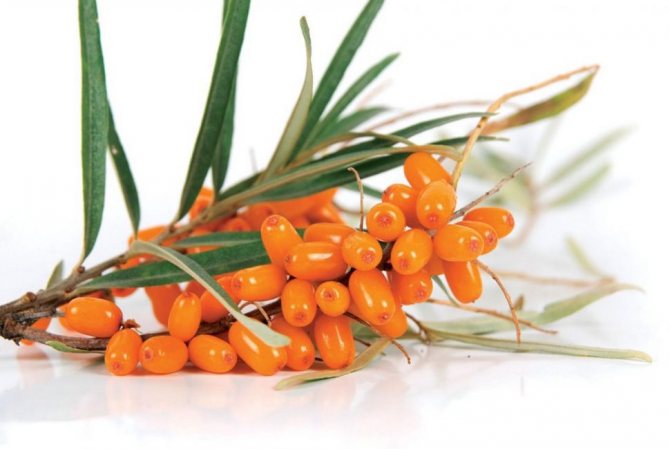

Augustine's sea buckthorn This variety is slightly similar to the previous one, the adult bole is distinguished by a spreading crown with characteristic green leaves. In terms of ripening Augustine is considered early ripening, the ripening of fruits begins at the end of July under appropriate weather conditions, in the northern regions the fruits of sea buckthorn will ripen no later than August, from here and the name of the variety.
Distinctive characteristics are:
- fruits are orange and ovoid
- berries are large enough, each weighs a little over a gram
- the fruits are collected on the branches in bunches, which, when ripe, yield the harvest without problems
The presence of a small number of thorns is allowed on the trunk. An important point is the yield, an average of 16-18 kg of useful berries are harvested from an adult tree.
The sea buckthorn variety grows in regions with different weather conditions, it tolerates both the cold and the lack of moisture in the required quantities. Not afraid of fungal diseases, resistant to various pests.
back to menu ↑
See also: Pear: a description of the 24 best varieties with their photos and gardeners' reviews
Elizabeth
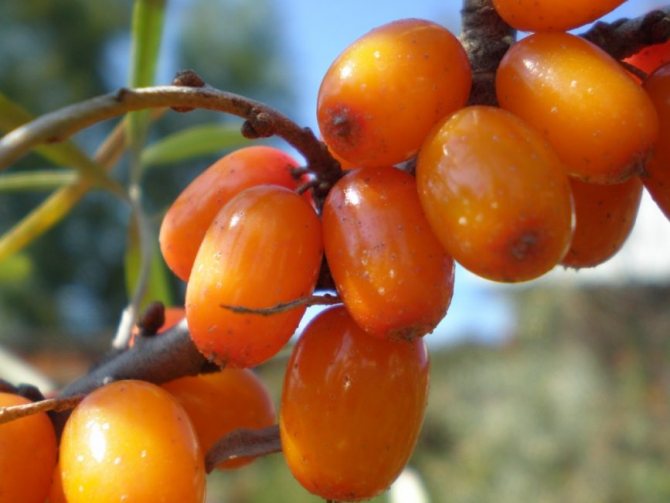

Elizaveta variety Pests are not terrible for the sea buckthorn variety Elizabeth, but it will have a later ripening period. An adult bole looks more like a shrub with a compact crown than a tree. The plant will not take up much space in the garden, but it will be generous in fruit. With proper care, it will be possible to harvest up to 14 kg of berries from it annually.
In the care for Elizabeth, the main thing is pruning, but it is also carried out once a year, in early spring. The rest of the stem is absolutely identical to any sea buckthorn.
Distinctive features of Elizabeth are recognized:
- large fruit size, each can reach up to a gram
- the variety is appreciated for its taste, ripe berries have a pleasant sweet and sour taste and a light pineapple aftertaste
- the trunk is not afraid of severe frosts
- pests and diseases will not overcome the shrub with proper care
Later ripening periods endowed the fruits with a strong skin, which reliably keeps the pulp from damage and spoilage. Thanks to this, the berries are kept fresh for a long time, they are canned and frozen to increase the shelf life.
back to menu ↑
See also: Sea buckthorn: description, cultivation, useful properties and contraindications, treatment, preparations for the winter - a symphony of benefits and taste! + Reviews
Essel
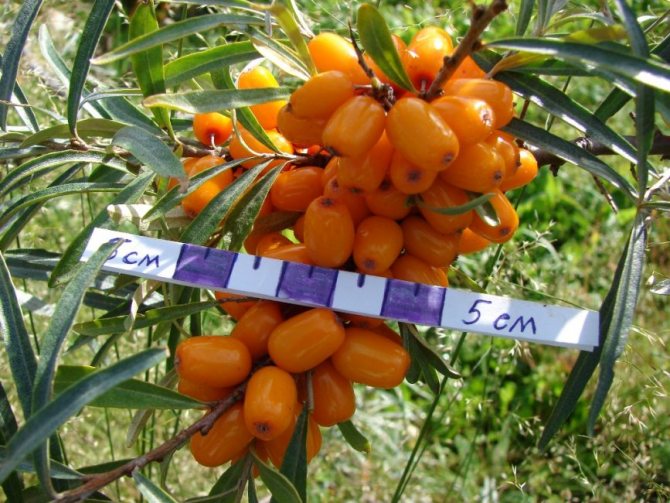

Essel The variety belongs to the novelties of Siberian selection, it is several years old. But even in such a short period, the stem managed to win the sympathy of many gardeners in this region.
Among the advantages of the variety are:
- excellent taste characteristics, dessert taste cannot be confused with any other variety
- large fruits are also characteristic of Esseli, each of them can reach up to one and a half grams of weight
- the trunk is characterized by oval-shaped fruits with a rich orange color
Fruit ripening begins in mid-August, in the southern regions the berries are poured earlier. It is worth paying special attention to the berries during this period, overriding they will fall from the branches, since they have underdeveloped stalks that collect them in a brush on the branches.
The stem does not need special care, the main thing is to trim the branches and form the crown. In the future, it is enough to remove dry and old branches, then fruiting will be abundant, the size of the berries will remain the original.
This bole is especially in demand among the residents of Altai.
Growing
For growing in the garden, as a rule, one- or two-year-old seedlings are purchased. Sea buckthorn loves sunlight, so a well-lit area should be chosen for trees and shrubs. At the bottom of the planting pit (depth and diameter 50 cm), with a close occurrence of groundwater, rubble, broken brick, shell rock are placed. A mound of earth is poured on top of the drainage layer, the roots are straightened, carefully covered with soil. After shrinkage, the root collar should be at ground level... The plant must be watered, the trunk circle must be mulched with dry soil. To obtain a future harvest, female and male plants should be planted in a ratio of 5: 1.
It is recommended to plant young plants in early spring. If you postpone the procedure to autumn, the risk of sea buckthorn awakening increases during the "February windows" (warming period). Since the seedling does not have time to fully adapt, it often freezes after a thaw.
Sea buckthorn is propagated mainly by green and lignified cuttings. In the first case, 15-centimeter cuttings are cut in the middle of summer. After treatment with growth stimulants, they drop it into a mixture of fertile soil, peat, river sand, equip a greenhouse. The cuttings are regularly watered, ventilated, after the appearance of the root, they are fed with complex mineral fertilizers. After two months, the shelter is removed. After wintering, they are transplanted to a permanent place.
Lignified cuttings are cut in autumn or winter, buried in the ground. In the spring they are placed in water until the buds appear. Then they are planted on a bed with fertile soil so that two buds remain above the ground, covered with a film. Cuttings need constant watering. They are transplanted to the allotted area after reaching a half-meter height.
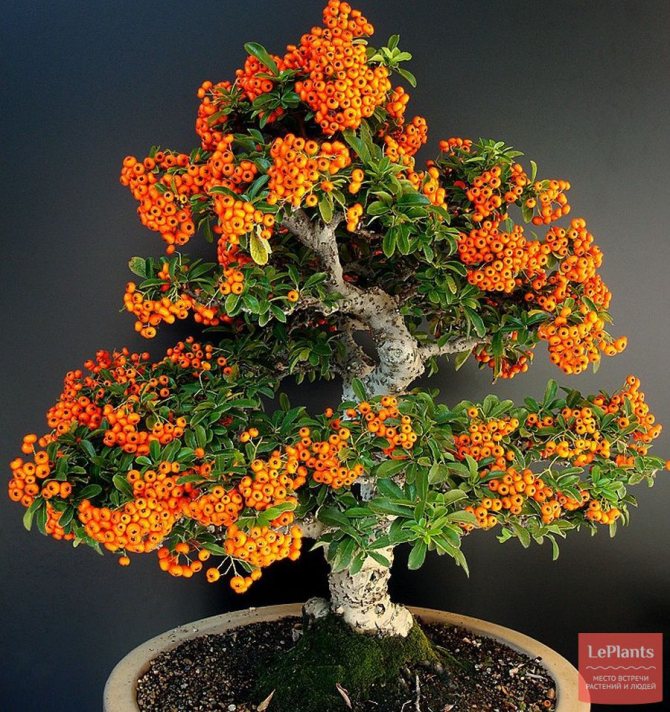

ON THE PICTURE: With seed reproduction, varietal characteristics are lost. Therefore, this method is mainly used by bonsai lovers.
Sea buckthorn berry juice
Squeeze the juice from the washed sea buckthorn berries. There are 300 g of sugar per liter of juice. Put on low heat, grind sugar until completely dissolved. The fire is added a little, stirring constantly, it is brought to a boil. Poured into sterile jars, rolled up.
- drink as a tonic, for the prevention of influenza and colds, half a glass daily
- good antitussive agent, used with honey
- with hair loss, oily seborrhea
- has antibacterial effect
- increases the level of hemoglobin in the blood
- increases the antitoxic function of the liver
- removes cholesterol in the blood
- helps - hypoacid gastritis, chronic colitis
- treats cholecystitis and other liver diseases
- strengthens blood vessels
- clears the lungs of pus
- thins the blood
- recommended when working in hot shops, in chemical production, radiation
- for the treatment of toxic liver damage
Success secrets
Since the root system of the plant is close to the soil surface, digging of the soil cannot be carried out. This will lead to a decrease in fruiting or death of the Sea Buckthorn. In addition, if the roots are damaged, abundant growth appears, which is then difficult to get rid of.Only slight loosening after heavy rains or watering is permissible. It is necessary to remove weeds near young trees and shrubs.
After the snow melts, sea buckthorn is fed with ammonium nitrate. Fertilizers are scattered on the soil surface, covered with a thin layer of earth on top. Once every two to three years in the fall, it is recommended to apply phosphorus-potassium fertilizers to the root zone.
For the development and fruiting of the plant, watering is required. It is very important to provide the shrub with moisture during the flowering period, during the ripening of the fruits, as well as on the eve of winter rest.
Pruning is one of the mandatory care measures for Sea Buckthorn. In the first four to five years, the crown is formed. To do this, in early spring, before bud break, branches growing parallel to the main trunk, as well as those whose length exceeds the desired plant size, are removed. Also, preventive pruning is carried out annually, getting rid of frozen and broken shoots. At the age of 10–12 years, Sea buckthorn requires rejuvenating pruning "on a stump", which promotes the emergence of new growth.
Pests and diseases
As a rule, the sea buckthorn tree does not feel well from fluctuations in temperature and humidity. The most serious ailment is verticillary wilting. This is a deadly disease in which the berries shrivel and dry out. Sick branches must be cut and thrown away. If this disease is detected again in the next year, the tree must be disposed of.
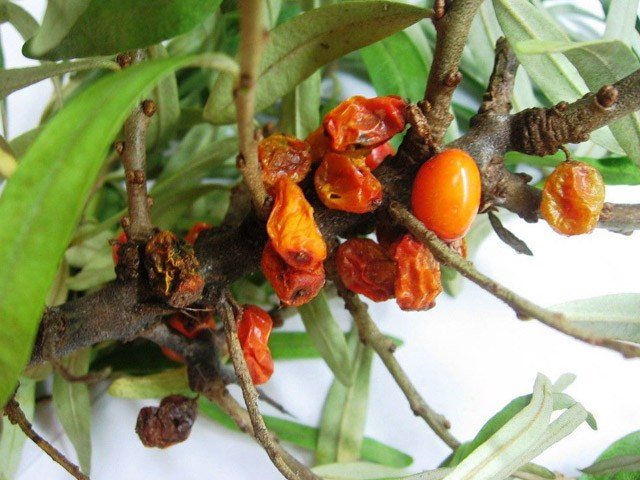

Such pests are known:
- Sea buckthorn moth. Caterpillars of these parasites crawl inside the kidney and eat away at the core. Spraying with Chlorophos can help get rid of parasites. This can be done before bud flowering.
- The same method is used in the fight against sea buckthorn fly. She has the ability to consume crops.
- Sea buckthorn aphid affects the leaves of the tree. They very quickly zholnitsya and fall off. A decoction with onion or garlic husks, or 10% Karbofos will help to get rid of parasites.
Possible difficulties
The main difficulty awaits gardeners at the stage of choosing seedlings. It is quite easy to distinguish male and female plants during the period of budding. In male specimens, they are large, covered with 6–7 scales. Women are not only much smaller in size, but they also have only two scales. However, sex is visible only in plants that have entered the fruiting age (three years old). Therefore, it is recommended to purchase planting material in nurseries. In addition, often female specimens with a grafted branch of the male go on sale.
The actively growing root system of the Sea Buckthorn is able to displace other plants. Restraining root growth will help restrict growth, for example, pieces of slate.
Editorial staff
The benefits of sea buckthorn leaves
- leaves, berries are useful - rheumatism, gout, diabetes mellitus - 10g infusion per 200ml;
- decoction of herbs - gastrointestinal diseases, skin diseases;
- treatment of skin diseases - baths with infusion of branches, sea buckthorn leaves;
- decoction of fruits, branches - hair loss, baldness. Drink broth without measure, wash your hair;
- sea buckthorn leaf tea - anemia, scurvy, rheumatism, gout, stomach and intestinal diseases.
Properties of sea buckthorn oil
Since ancient times, it has been used to treat wounds. Medicine was recognized in the seventies. Now it is produced industrially, which preserves the healing properties of sea buckthorn.
- sea buckthorn oil, juice - hypovitaminosis, prevention of early aging, muscle dystrophy;
- used as a prophylactic agent against atherosclerosis, prevents the development of the disease. When taking the oil, the general condition is significantly improved;
- oil, sea buckthorn berry juice - affect the exchange in blood serum;
- useful for ischemic heart disease;
- reduces the acidity of gastric juice;
- normalizes blood pressure;
- restores liver cells after alcohol poisoning;
- regulates fat metabolism;
- sea buckthorn oil is useful for angina pectoris. With continued use of oil, the number of seizures decreases
- inhalations with sea buckthorn oil - prevention of upper respiratory diseases for people working in hazardous industries;
- heals tumors, inflammation;
- helps - stomach ulcer, duodenal ulcer, colitis;
- chronic tonsillitis, stomatitis;
- malignant tumors of the esophagus;
- thermal, chemical burns of the skin;
- acute, chronic laryngitis, pharyngitis - lubricate problem areas with sea buckthorn oil or do oil inhalations every day for 15 minutes a month;
- chronic, acute sinusitis - lubricate the upper sinus with sterile vegetable oil;
- treatment of pressure sores, trophic ulcers - the cleaned wound or the surface of the ulcer is washed with a solution of penicillin. Apply oil liberally, with a bandage on top. The bandage is fixed as it will have to be held until the appearance of granulations filling the wounded surface. Change the bandage every other day;
- erosion of the cervix, traumatic damage to the mucous membrane, colpitis - the mucous membrane of the vagina, the cervix is lubricated with sea buckthorn oil, cotton swabs with oil are used;
- the most valuable remedy for the treatment of oncology. In the treatment of esophageal cancer with X-ray rays, half a tablespoon is used for three weeks three times a day;
- it is advisable to use after operations on the esophagus;
- recommend - eye injuries, corneal defects;
- helps - conjunctivitis ulcers, keratitis, trachoma;
- radiation damage, eye burns;
- skin diseases - eczema, scaly lichen, tuberculosis of the skin, acne, lupus;
- hair loss - taken orally, rubbed into the scalp
Undersized
Collecting sea buckthorn by hand is a very time-consuming job. The dense arrangement of berries simplifies the task a little. However, difficulties arise if the plant is tall enough, i.e. harvesting requires the use of adaptations and additional time. If the bush is short, everything is much easier.
This is the advantage of undersized varieties:
- Inya;
- Druzhina;
- Amber.
Important! Vitamin C is retained in the composition of sea buckthorn in the same amount, regardless of the type of processing of berries.
Inya
Inya ripens early and brings up to 10 kg or more.
Main characteristics:
- medium height bush, usually with several trunks;
- not particularly dense crown;
- the lower shoots are gray, and in the middle - brown, with a slight shade;
- large leaves, dark green;
- the shape of the fruit is closest to the cylinder;
- ruddy reddish berries;
- slightly sweet taste and pronounced odor.
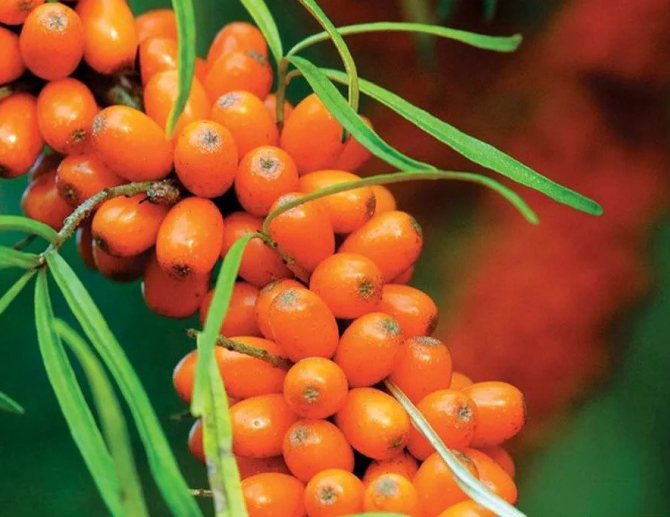

The variety is hardy and frost-resistant.
Druzhina
Early ripening period.
Distinctive features:
- slightly spreading form;
- straight shoots of light brown color with a grayish bloom;
- the green leaf surface is matte, smooth and leathery;
- the berries are round or oval;
- medium fruiting (up to 9 kg).
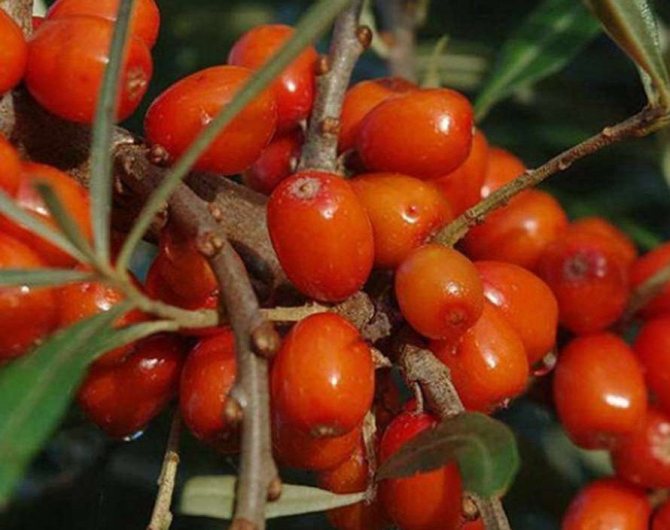

The variety is not afraid of cold weather and successfully resists fungi and insects.
Amber
This is a medium-sized shrub that pleases with an impressive harvest of more than 10 years. It begins to bear fruit no earlier than 2-3 years later, and at the age of 5 it gives the maximum amount - more than 10 kg. Late summer fruiting period. Berries are processed in all sorts of ways.
Did you know? In ancient Greece, the plant was called "the shiny horse", since the animals that grazed in its thickets were distinguished by a shiny skin and a beautiful mane.
It is important to note in the description:
- rare spherical crown;
- almost completely smooth shoots;
- fruits of "red" color weigh 0.7-0.9 g;
- sweet and sour aftertaste.
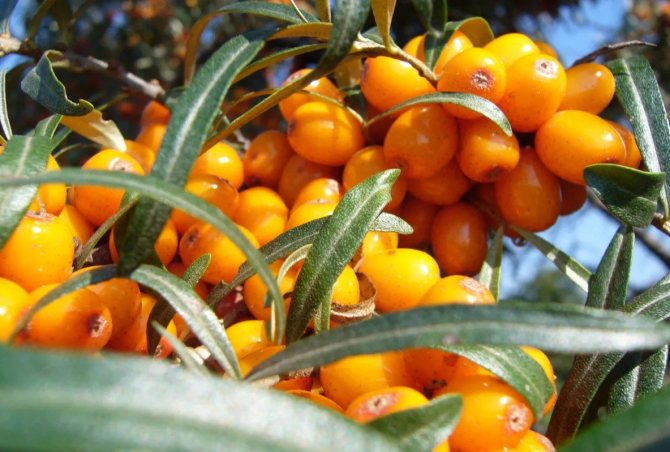

Amber without much difficulty adapts to difficult weather conditions, rarely gets sick and is not afraid of pest attacks.

